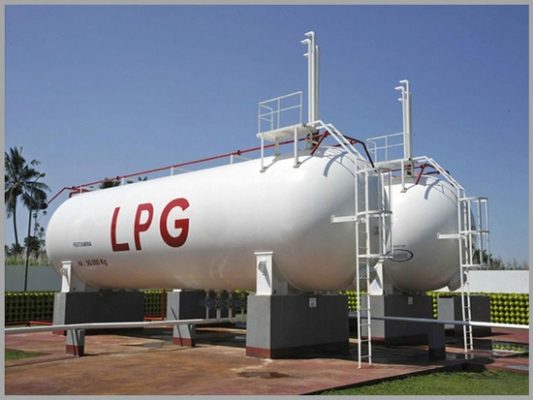LPG GAS TANK INSTALLATION
Phuc Sang Minh is a leading company in the Gas/Energy market in Vietnam and the region. We specialize in consulting, designing, and installing residential gas systems for high-rise buildings and apartments, as well as supplying liquefied gas systems for industrial zones. Specifically, we are experts in installing LPG gas tanks.
❖ Tank Placement and Safety Distance
- LPG tanks must be installed outdoors, outside of enclosed buildings. They should not be placed on rooftops, balconies, basements, or beneath structures.
- Tanks should not be installed under structures like house eaves, bridges, or overhead power lines. The safety distance from the tank to overhead power lines must comply with electrical safety regulations.
- Tanks should not be stacked on top of each other. Horizontal cylindrical tanks should not be placed end-to-end but should be aligned parallel to the axis and away from residential or service buildings.
- If the LPG tank area is near a pathway leading to a crowded area, a protective open-type fence must be installed around the tanks.
- The safety distance from LPG tanks to flammable liquid tanks with a flash point below 65°C must be no less than 7 meters.
- Measures must be in place to eliminate all potential ignition sources within the tank area.
- The safety distance between LPG tanks and hydrogen or oxygen tanks must follow specific regulations.
- Ensure minimum safety distances between tanks and protected objects, as well as between the tanks themselves.
❖ Tank Installation
For underground LPG tank installation, the following must be observed:
- Tanks must be installed in a dedicated compartment filled with clean sand. The compartment walls must be watertight and at least 200 mm thick.
- The compartment top must be designed to withstand load, preventing damage if vehicles pass overhead in emergencies.
- Protect connection boxes, tank fittings, and pipelines from vehicle impacts.
- Tanks must be coated or protected to minimize corrosion.
- Any damage to the coating must be repaired before installation.
- Tanks should be installed level and covered with tightly compacted soil or sand, free from stones or abrasive materials.
For mounded tank installation:
- Fill material should be soil, sand, or other non-flammable, non-corrosive materials, with a minimum thickness of 0.3 meters.
- Protective covers must be equipped on top of the fill material to prevent erosion.
- Valves and tank accessories must be easily accessible for operation and maintenance without needing to dig up the fill material.
- Mounded tanks must be coated or protected to minimize corrosion.
For further details on regulations and installation procedures, please visit our website or contact our hotline for the quickest information. We look forward to collaborating with our customers.





